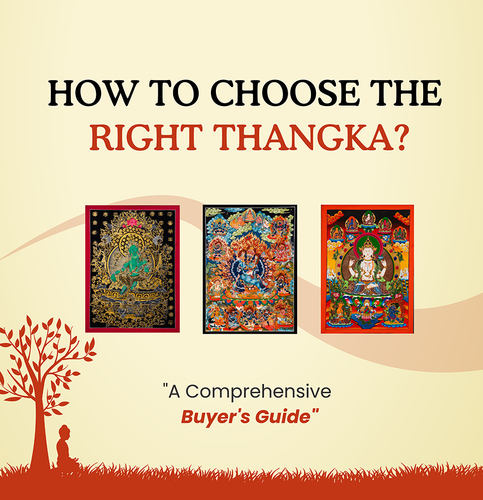
How to choose the right Thangka?
Share
When you're looking to bring the profound beauty of Tibetan Buddhist art into your life, choosing the right thangka is a deeply personal and meaningful decision.
Whether you're adding a sacred touch to your home or enhancing your meditation practice, here's everything you need to know before making your decision.
1. Define Your Purpose
First, start by asking yourself: "What draws me to a thangka?" Your purpose will lead you to the right choice:
- Meditation Focus: If you’re a devoted practitioner, select a thangka that features your personal deity (yidam) or a Buddha aspect that resonates with your practice. You may choose a thangka that connects with a personal deity you feel a strong bond with to amplify your meditation experience. Or, if you’re focusing on qualities like compassion or wisdom, find a thangka that represents these aspects of the Buddha’s teachings.
- Spiritual Learning: If you aim to deepen your understanding of Buddhist teachings, go for thangkas that illustrate key teachings or significant moments in Buddha’s life. Look for thangkas that depict important teachings, such as the Four Noble Truths or the Eightfold Path. Or, you may pick thangkas that tell meaningful stories from Buddhist texts, offering both visual beauty and spiritual reflection.
- Home Decoration: : If your intention is to create a harmonious atmosphere at home while maintaining the sacred nature of the artwork, consider thangkas that are visually appealing and align with your aesthetic preferences. For that, opt for colors and designs that complement your living space while reflecting serenity and peace. Ensure that the thangka maintains its spiritual significance even as it serves as decorative art.
- Temple or Shrine Room: If you're creating a space for worship or personal devotion, larger, more detailed thangkas can serve as awe-inspiring focal points. For temple settings, go big—grand thangkas make an impressive statement and elevate the sacred atmosphere. Similarly, try to find thangkas rich in symbolism that inspire reverence and contemplation, especially in communal settings.
2. Select the Right Deity or Theme
When selecting a deity or theme for your thangka, consider your spiritual goals and the qualities you wish to cultivate in your life. Each figure offers its own set of blessings that can support your personal growth and understanding of Buddhist teachings.
Buddha Shakyamuni:
Perfect for those beginning their spiritual journey or seeking enlightenment. Shakyamuni Buddha represents the path to ultimate wisdom and serves as a guide for personal transformation.
Green Tara:
Ideal for those in need of protection and swift assistance. Known for her compassionate and active nature, Green Tara helps remove obstacles and offers immediate support during times of fear or difficulty. Her mantra, "Om Tare Tuttare Ture Svaha," is frequently recited for invoking her powerful support.
Medicine Buddha:
Focused on healing, both physically and spiritually, Medicine Buddha is a perfect companion for those in healing professions or embarking on a personal wellness journey. His presence promotes recovery, vitality, and overall well-being.
Mandalas:
Excellent for meditation and gaining insight into cosmic principles, mandalas are visual tools that help center the mind and connect with the universe's deeper patterns. They symbolize the cosmos and assist in unlocking profound spiritual realizations.
Wheel of Life:
This thangka is great choice if you're interested in Buddhist philosophy and the workings of karma. The Wheel of Life illustrates the cycle of birth, death, and rebirth (samsara), offering a visual representation of karma’s role in the interconnectedness of all beings.
3. Consider the Size and Space
Your thangka deserves to shine in its designated space, and choosing the right size can make all the difference.
As you measure your space, remember to account for mounting space and any brocade borders that add to its overall dimensions. And don’t forget the lighting! Proper lighting can bring out the vibrant colors and intricate details, elevating both the visual and spiritual experience of your thangka.
Here’s how to match your thangka’s size to its intended location for the most harmonious and impactful display:
- Small (12-24 inches): Perfect for personal altars or meditation corners. These smaller pieces are intimate and can easily fit into cozy spaces. They are perfect for individual practice, allowing for close contemplation and connection. Position them at eye level to enhance visibility during meditation or prayer. Consider using small stands or hanging them on walls to create a dedicated meditation nook.
- Medium (24-36 inches): Perfect for home shrines or study rooms, medium-sized thangkas offer a beautiful balance between visibility and intimacy. They can be a focal point in your home shrine, inviting deeper engagement, while also serving as decorative elements in shared spaces. Hang them near your desk or in a reading nook for a spot that encourages reflection, but ensure there's enough wall space around them for a clean, uncluttered feel.
- Large (36+ inches): For temples, meditation halls, or spacious rooms, large thangkas make a bold, awe-inspiring statement. These majestic pieces shine in communal settings, where their intricate details are visible from afar. Mount them on prominent walls where they can serve as focal points during group practices or ceremonies. Be sure to leave ample space around the thangka, allowing viewers to appreciate its grandeur without feeling cramped.
4. Evaluate Quality and Craftsmanship
When selecting a thangka, it’s crucial to assess its quality and craftsmanship to ensure you’re acquiring a piece that’s not only visually striking but also spiritually significant. Here's how to evaluate the key characteristics that define a high-quality thangka.
- Materials: Authentic thangkas use natural mineral pigments, ensuring vibrant, lasting colors. Look for pigments like lapis lazuli, cinnabar, and gold, which not only enhance the artwork's beauty but also contribute to its durability. Genuine 24-carat gold highlights are often used to add a touch of luxury and spiritual significance. At Fine Thanka Art, we use only natural pigments and authentic materials, ensuring that every piece is not only beautiful but ethically made.
- Canvas: The finest thangkas are painted on premium cotton canvas that’s been properly sized and prepared. This ensures the piece lasts for generations and maintains its structural integrity over time.
- Brushwork: Inspect the brushwork closely—high-quality thangkas display clean, precise lines and even color application throughout. The finer the details, the more skilled the artist, ensuring that the thangka reflects traditional techniques with accuracy.
- Detail: Pay attention to the facial features and the proportions of figures in the artwork. A well-crafted thangka will feature clear, expressive faces and harmoniously balanced figures, demonstrating the artist’s expertise and respect for time-honored practices.
- Brocade: The silk brocade used for mounting should be of the highest quality, with colors that complement the thangka. A well-chosen brocade not only enhances the piece’s visual appeal but also elevates the overall aesthetic, creating a unified, elegant presentation.
5. Understand Price Points
The price of a thangka reflects the quality of materials and the skill of the artisan behind it. As you explore thangkas, keep in mind that the price can vary widely based on size, detail, and craftsmanship.
No matter your budget, there's a thangka that can bring beauty and spiritual depth into your life. Choose wisely based on your taste, intentions, and the level of craftsmanship you're looking for.
- Entry-Level ($200-$500): These are smaller, simpler thangkas, often suited for beginners or casual collectors. While they may not have the intricate detailing of higher-end pieces, they still offer a meaningful connection to Tibetan Buddhist art.
- Mid-Range ($500-$2000): For those seeking more detail and craftsmanship, mid-range thangkas showcase better materials and artistry. You’ll find better brushwork, richer colors, and a more refined aesthetic. These pieces offer a beautiful balance between affordability and quality, making them ideal for collectors who appreciate both beauty and value.
- High-End ($2000 and above): Reserved for true masterpieces, these thangkas are created by master artisans using traditional techniques and luxurious materials like gold. With intricate designs and extensive gold work, these pieces make a bold statement and are perfect for collectors who value artistry at its finest.
6. Seek Expert Guidance Before You Buy
When selecting a thangka, it’s always wise to consult with knowledgeable sources to ensure you’re making an informed and meaningful purchase.
- Consult Buddhist Teachers: They can provide insights into appropriate deities for your practice and help you understand the significance of different themes.
- Ask Artisans: Don’t hesitate to engage with the artisans themselves. Ask about their techniques, materials, and the story behind the piece you’re considering. This conversation can give you a deeper appreciation of the craftsmanship and intention that went into creating the thangka.
- Request Documentation of Authenticity: To ensure you’re getting an authentic piece, ask for documentation verifying the thangka’s origins and traditional craftsmanship. This will give you peace of mind knowing it’s a genuine work of art.
- Learn About Care and Display Methods: Ask the experts about proper care and display practices to maintain the thangka's integrity for years to come. Knowing how to display and protect your thangka will help preserve its beauty and spiritual significance.
Making Your Final Decision
When it’s time to choose your thangka, trust your intuition while staying well-informed. The right piece should resonate with you on a deeper level, both visually and spiritually, becoming a meaningful companion on your journey. Take your time in selecting, as this sacred artwork will be a long-lasting presence in your practice or home. Make sure it not only enhances your space but also supports and elevates your spiritual path.
Frequently Asked Questions
How can I tell if a thangka is authentic?
To ensure your thangka is authentic, look for hand-painted details, the use of natural pigments, and well-executed proportions. Genuine thangkas are often accompanied by documentation and are created by recognized artists.
How should I display my thangka?
Mount it at eye level, away from direct sunlight and moisture. Traditional silk brocade mounting is recommended for protection and respect.
Can I roll up my thangka for storage?
Yes, you can roll up your thangka, but make sure to roll it face-out around a wooden dowel, wrap it in silk, and store it in a cool, dry place to preserve its integrity.
Do I need to have my thangka blessed?
While not mandatory, many practitioners choose to have their thangkas blessed by a qualified Buddhist teacher to activate their spiritual potential.
Conclusion
Whether you're looking for healing, protection, wisdom, or a deeper connection to the universe, select the thangka that speaks to your personal journey and enhances your spiritual path.
At Fine Thanka Art, we offer authentic Thangka paintings, each created with love, precision, and deep spiritual intention. You'll find the perfect masterpiece that resonates with your soul.
Add to Cart now to purchase your Thangka online. Or, pick up from our store at Thamel to experience our exquisite collection in person!
